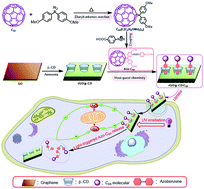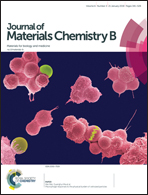Light-triggered C60 release from a graphene/cyclodextrin nanoplatform for the protection of cytotoxicity induced by nitric oxide†
Abstract
An ultraviolet (UV) light-triggered nanocarbon hybrid is developed for controlled C60 release with excellent nitric oxide (NO) quenching ability. This nanocarrier, consisting of reduced graphene oxide (rGO) and β-cyclodextrin (β-CD), is capable of hosting azobenzene functionalized C60 (Azo–C60) synthesized by diazo chemistry. The hybridization of rGO, β-CD and Azo–C60 enhances cellular uptake and limits the aggregation of C60, and shows enhanced protective effects on NO-induced cytotoxicity. More interestingly, azo groups can reversibly switch between trans- and cis-isomers upon UV irradiation, so that the Azo–C60 molecules exhibit photo-controlled release from rGO/β-CD in living cells. In vitro studies show that rGO/β-CD/C60 treated with UV irradiation causes higher NO scavenging efficacy, which further significantly increases the cell viability from 32.6% to 88.4% at low loading levels (50 μg mL−1). This represents an excellent NO quenching efficiency, better than other reports of the graphene/C60 nanohybrids, and indicates that this material can be an effective nanoplatform to combat oxidative damage. As the host–guest chemistry and diazo chemistry are versatile and universally applicable, it is worth noting that the present strategy can also be applied in preparing other photo-responsive nanohybrids, which should be valuable for use in life science and materials science.

- This article is part of the themed collection: International Year of the Periodic Table : Low Dimensional Carbon Systems


 Please wait while we load your content...
Please wait while we load your content...